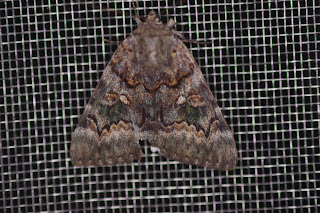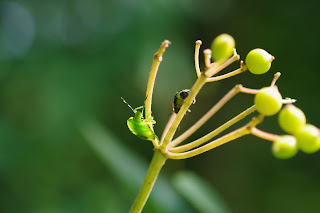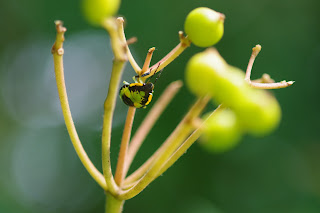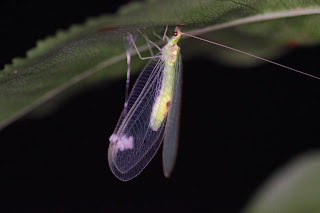One of the best things about this whole Backyard Bug project is learning. About bugs, about plants, about fungus–things I learned directly because looking for information about bugs related to things they eat, or where they live, but also things I learned just because spending so much time looking at the little details of my backyard natural world has led to observations of things other than bugs. Admittedly I don't bother to look up a lot of things, but often when I do, I learn new things about related subjects. Like trying to identify a bug I have seen often means I find out about the bugs that are similar, but not the one I am trying to identify.
What a muddled explanation. All to say, when I found today's Backyard Bug of the Day, I knew what it was, because I have spent enough time looking for identifications of other bugs that I recognized it when I saw it. I still looked it up, but I had a wonderful moment of thinking, "Oh, I know what that is."
So here it is, Backyard Bug of the Day:
This is an antlion, which I found on my front porch when I got home this evening. I know I have seen these before; years before I started my BBotD project there was one in my house, caught in the cupola at the top of the house, trying desperately to get out by bashing against the windows. I captured it and brought it outside, and left it sitting on a flower. At the time I thought it was a dragonfly. I didn't know much about bugs then, not even enough to know that this looks more like a damselfly than a dragonfly–at the time I didn't know those were not the same thing. But now I know it is neither a dragonfly nor a damselfly, and it's not even in the same order.For the last couple of days part of an antlion has been stuck to the wall of my front porch, caught in a spider web:
But just on wings along I wasn't able to identify it, or recognize it, really.
There was another insect on the front porch that looks a tiny bit similar:
Fishfly. Similar enough to antlions that in the past I might have easily confused the two, a bit like I used to not notice the difference between monarch butterflies and viceroy butterflies, but now that I know the difference, they don't look the same at all. Interestingly, antlions and fishflies used to be in the same order, but now they are classified differently, and are in separate orders (Neuroptera and Megaloptera respectively). These are also very similar to Dobsonflies, which I would love to see on my front porch.
Since we're out on the front porch with these, I'll post the rest of the porch pictures before I go on to my walk pictures...
An interesting thing about this moth... It looks like this on the wall...
... but when it moved to the screen door the colors looked different. I assume it had to do with the angle of the light, or something like that, but it surprised me. I like it better like this.
And here's a close-up:
Hm. Well, there were a lot of bugs on the porch, but apparently I didn't take pictures of many of them!
Anyway, I took my camera on my walk today...
The promethea caterpillar is still around. It's hard to tell, but I think it has gotten bigger in the last couple of days since I first saw it. I am still waiting to see if the knobs on its back turn red.
I found part of a bug in the stream. Not enough for me to be able to identify it. The wings are a bit like a stonefly, but I have never seen a stonefly this big.
Frogs have been scarce lately, which may have something to do with the fact that there is almost no water left in the stream.
Japanese beetles
Leaf footed bug, I think.
I detoured into the meadow in the hopes of finding grasshoppers and katydids. I was surprised to only see a couple of them. I only got pictures of this one.
Tiny ailanthus webworm caterpillar. I finally looked up something I have been curious about for a while. Ailanthus tree is an invasive species, and the preferred host of the ailanthus webworm moth. I have wondered for a while if the moth/caterpillar is also an introduced species, and if it is invasive. Because if it only feeds on the ailanthus tree, then it's fine to have around, I figured. Ailanthus is also the preferred host of the spotted lanternfly, but spotted lanternflies will feed on lots of species of trees and vines, that is what makes them such a menace. But according to what I read, ailanthus webworm caterpillars mostly only feed on ailanthus trees, so they are actually beneficial, because they are eating an invasive species (but not really, because they don't eat enough to harm the trees, which is how c-oevolution sometimes works). But in their adult stage as moths they are pollinators. So... that puts them in the plus column. All in all, a fine species to have around, which I have to say is quite a relief to me.
Most of the bugs I saw today were really uncooperative:
First time in a while I've seen a frog on the bathtub (there were two frogs, actually, but the other one was in the tub, and dove under when I showed up with my camera). The water level has gone down ever so slightly–we've had very little rain the last few weeks, and the drip from the pipe into the tub is veeeeeeeery slow now.
These might be two different instars of the same species of stinkbug:
Ebony jewelwing. Too far to see the slight resemblance to the antlion.
I think this is a female blue dasher dragonfly. The male of the species is blue; the female is not.
The goldenrod was a hot spot for bugs today, especially honeybees:
And flies, and bumblebees...
Here's some pictures I took on my bug walk yesterday, which was very short:
I don't know what species of leaf hopper these are, but there are a lot of them around lately, and they have been hanging out in groups.
Ailanthus webworm caterpillar. You can just barely see, blurred out in the background, that there was another one in this web.
Some pests:
More of the dreaded spotted lanternfly nymphs. On ailanthus, their favored host plant.
I think this is a potato beetle larva, on the zucchini in our garden. We've had these destroy our entire zucchini plantings before, but there's just a couple on there now, so I don't feel like removing them.The Promethea caterpillar:
Arachnid Appreciation:
.
.
.
.
.
.
.
.
.
.
.
.
'Tis the season for spined micrathena spiders...
And also why this one was on the ground:























































